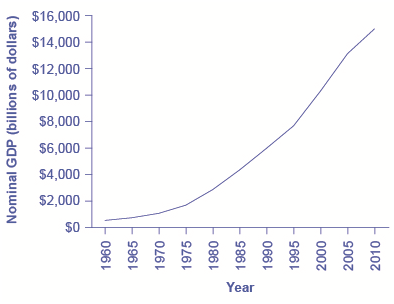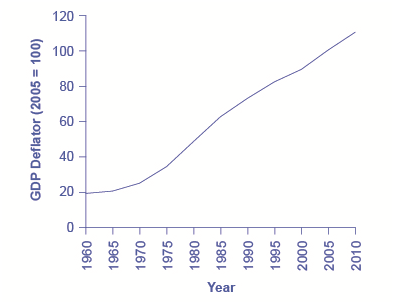3.8 国内生产总值和物价水平变化
章节大纲
-
GDP & Changes in the Price Level
::国内生产总值和物价水平变化While the concept of GDP is easy enough for the consumer to understand, it is the actual calculation and interpretation of GDP that gives economists a clear picture of what the economy is doing over a year. Is the economy expanding? Is it contracting? What is inflation like? How many durable goods or homes are consumers purchasing? How much of person income is being spent? The measurements and the analysis that follows is instructive as to how the circular flow of economic activity of a country is performing. It follows that the measure of a nation's production is crucial to determine whether or not there should be a reallocation of resources, or if government regulations need to be changed.
::虽然国内生产总值的概念对消费者来说是容易理解的,但实际的计算和对国内生产总值的解释却使经济学家清楚地了解经济在一年中正在做什么。经济是否在扩张?经济在萎缩?通货膨胀是什么样子?消费者购买了多少耐久的商品或住房?消费者购买了多少耐久的商品或住房?花费了多少人的收入?下面的衡量和分析对一个国家经济活动的循环流动如何进行具有指导意义。因此,衡量一个国家的生产量对于确定是否应该重新分配资源或是否需要改变政府条例至关重要。Universal Generalizations
::普遍化-
Economists examine Gross Domestic Product at existing prices and adjusted for inflation to make comparisons over time.
::经济学家按照现有价格审查国内生产总值,并根据通货膨胀进行调整,以便作一段时间的比较。 -
Economists use a market basket, consisting of items most frequently purchased by consumers, to construct the price index.
::经济学家利用由消费者最经常购买的物品组成的市场篮子来建立价格指数。 -
It is important to track inflation because it distorts the economic statistics we keep regarding how well the economy performs.
::重要的是跟踪通货膨胀,因为它扭曲了我们所保持的经济统计数据,说明经济表现如何。
Guiding Questions
::问 问 问 问 问 问 问 问 问 问 问 问 问 问 问 问 问 问 问 问 问 问 问 问 问 问 问 问 问 问 问 问 问 问 问 问 问 问 问 问 问 问 问 问 问 问 问 问 问 问 问 问 问 问 问 问 问 问 问 问 问 问 问 问 问 问 问 问 问 问 问 问 问 问 问 问 问 问 问 问 问 问 问 问 问 问 问 问 问 问 问 问 问 问 问 问 问 问-
Why do economists construct a price index?
::为什么经济学家要建立价格指数? -
What does the consumer price index report?
::消费物价指数报告是什么? -
What does the producer price index measure?
::生产者价格指数衡量标准是什么? -
What kinds of information does the Bureau of Labor Statistics analyze?
::劳工统计局分析哪些信息?
Adjusting Nominal Values to Real Values
::将名值调整为实际值When examining economic statistics, there is a crucial distinction worth emphasizing. The distinction is between nominal and real measurements, which refer to whether or not inflation has distorted a given statistic. Looking at economic statistics without considering inflation is like looking through a pair of binoculars and trying to guess how close something is. Unless you know how strong the lenses are, you cannot guess the distance very accurately. Similarly, if you do not know the rate of inflation, it is difficult to figure out if a rise in GDP is due mainly to a rise in the overall level of prices or to a rise in quantities of goods produced. The nominal value of any economic statistic means the statistic is measured in terms of actual prices that exist at the time. The real value refers to the same statistic after it has been adjusted for inflation. Generally, it is the real value that is more important.
::在审查经济统计时,值得强调一个关键区别。 区别在于名义和真实的计量,即通货膨胀是否扭曲了某一统计。 在不考虑通货膨胀的情况下审视经济统计,就像通过双筒望远镜看一看一样,并试图猜测某物的近距离。除非您知道透镜有多强,否则无法非常准确地猜测距离。同样地,如果您不知道通货膨胀率,那么很难确定GDP的上升是否主要由于总体价格水平的上升或所生产货物数量的增加。任何经济统计的名义价值都意味着统计是以当时存在的实际价格来衡量的。实际价值是指根据通货膨胀调整后的同一统计数字。一般来说,实际价值才是更重要的。Converting Nominal to Real GDP
::将名义物转换为实际GDP1 shows U.S. GDP at five-year intervals since 1960 in nominal dollars; that is, GDP measured using the actual market prices prevailing in each stated year. This data is also reflected in the graph shown in 1
::1 显示自1960年以来美国国内生产总值每五年以名义美元表示一次,即以每一年实际市场价格计量的国内生产总值。Year
::年份 年份Nominal GDP (billions of dollars)
::名义国内生产总值(10亿美元)GDP Deflator (2005 = 100)
::国内生产总值减缩指数(2005年=100)1960
543.3
19.0
1965
743.7
20.3
1970
1,075.9
24.8
1975
1,688.9
34.1
1980
2,862.5
48.3
1985
4,346.7
62.3
1990
5,979.6
72.7
1995
7,664.0
81.7
2000
10,289.7
89.0
2005
13,095.4
100.0
2010
14,958.3
110.0
U.S. Nominal GDP and the GDP Deflator(Source:
::美国名义国内生产总值和GDP减缩指数(资料来源:Nominal GDP values have risen exponentially from 1960 through 2010, according to the BEA.
If an unwary analyst compared nominal GDP in 1960 to nominal GDP in 2010, it might appear that national output had risen by a factor of twenty-seven over this time (that is, GDP of $14,958 billion in 2010 divided by GDP of $543 billion in 1960). This conclusion would be highly misleading. Recall that nominal GDP is defined as the quantity of every good or service produced multiplied by the price at which it was sold, summed up for all goods and services. In order to see how much production has actually increased, we need to extract the effects of higher prices on nominal GDP. This can be easily done, using the GDP deflator.
::如果一个不谨慎的分析师将1960年的名义GDP与2010年的名义GDP进行比较,那么,这一时期的国民产出似乎增长了27倍(即2010年的GDP为14.958亿美元,除以1960年的GDP5.43亿美元 ) 。 这一结论将产生极大的误导。 回顾名义GDP的定义是每生产一种商品或服务的数量乘以其销售价格,对所有商品和服务进行汇总。 为了了解生产实际增长多少,我们需要提取高价格对名义GDP的影响。 使用GDP减缩器可以很容易做到。GDP deflator is a price index measuring the average prices of all goods and services included in the economy. We explore price indices in detail and how they are computed in , but this definition will do in the context of this chapter. The data for the GDP deflator are given in and shown graphically in .
::GDP减缩指数是衡量经济中所有商品和服务平均价格的价格指数。我们详细探讨价格指数及其计算方式,但这一定义将在本章中加以阐述。GDP减缩指数的数据以图表形式列出和显示。U.S. GDP Deflator, 1960–2010
::1960-2010年美国国内生产总值减缩指数Much like nominal GDP, the GDP deflator has risen exponentially from 1960 through 2010. (Source: BEA)
2 shows that the price level has risen dramatically since 1960. The price level in 2010 was almost six times higher than in 1960 (the deflator for 2010 was 110 versus a level of 19 in 1960). Clearly, much of the apparent growth in nominal GDP was due to inflation, not an actual change in the number of goods and services produced, in other words, not in real GDP. Recall that nominal GDP can rise for two reasons: an increase in output, and/or an increase in prices. What is needed is to extract the increase in prices from nominal GDP so as to measure only changes in output. After all, the dollars used to measure nominal GDP in 1960 are worth more than the inflated dollars of 1990—and the price index tells exactly how much more. This adjustment is easy to do if you understand that nominal measurements are in value terms, where
::2表明价格水平自1960年以来急剧上升。2010年的物价水平比1960年几乎高出6倍(2010年的减缩指数是110,而1960年的19位)。 显然,名义GDP的明显增长大部分是由于通货膨胀,而不是实际生产的商品和服务数量的实际变化,换言之,不是实际国内生产总值的实际变化。回顾名义GDP可以增长的原因有两个:产出增长和/或价格上涨。需要的是从名义GDP中抽取价格增长,以便只衡量产出的变化。 毕竟,用于计量1960年名义GDP的美元值高于1990年的膨胀美元 — — 价格指数表明到底要多多少。 如果知道名义计量是按价值计算的,那么这一调整很容易做到。Value GDP = Price × Quantity
::国内总产值价值=价格x数量Or
::或Nominal GDP Deflator × Real GDP
::名义GDP 名义GDP 减缩指数 = 实际GDPLet’s look at an example at the micro level. Suppose the t-shirt company, Coolshirts, sells 10 t-shirts at a price of $9 each.
::让我们看看微观层面的例子。 假设T恤公司(Cooleshirts)以每件9美元的价格出售10件T恤。Coolshirt's nominal revenue from sales = Price × Quantity $9 × 10 = $90
::冷却衫销售名义收入=价格 = 价格 = 数量 9 × 10 = 90Then, Coolshirt's real income = Nominal revenue
::然后,Cooleshirt的实际收入=名义收入Price $90/$9= 10
::90美元/9美元=10美元In other words, when we compute “real” measurements we are trying to get at actual quantities, in this case, 10 t-shirts.
::换句话说,当我们计算“真实”测量时,我们正试图取得实际数量,即10件T恤。With GDP, it is just a tiny bit more complicated. We start with the same formula as above:
::以GDP来说,它只是略微复杂一些。我们从上面同样的公式开始:Real GDP = Nominal GDP
::实际国内总产值=名义国内总产值Price Index
::价格指数For reasons that will be explained in more detail below, mathematically, a price index is a two-digit decimal number like 1.00 or 0.85 or 1.25. Because some people have trouble working with decimals, when the price index is published, it has traditionally been multiplied by 100 to get integer numbers like 100, 85, or 125. What this means is that when we “deflate” nominal figures to get real figures (by dividing the nominal by the price index). We also need to remember to divide the published price index by 100 to make the math work. So the formula becomes:
::出于下文将更详细地解释的原因,从数学角度讲,价格指数是一个两位数的小数数数字,如1.00或0.85或1.25。由于有些人在使用小数数工作时遇到困难,当价格指数公布时,通常会乘以100,以获得100、85或125等整数,这意味着当我们“缩小”名义数字以获得真实数字(将名义数字除以价格指数)时(通过将名义数字除以价格指数),我们还需要记住将公布的价格指数除以100才能使数学发挥作用。因此公式会变成:Real GDP = Nominal GDP
::实际国内总产值=名义国内总产值Price Index / 100
::价格指数/100Nominal GDP (billions of dollars)
::名义国内生产总值(10亿美元)GDP Deflator (2005 = 100)
::国内生产总值减缩指数(2005年=100)Calculations
::计算Real GDP (billions of 2005 dollars)
::实际国内生产总值(2005年10亿美元)1960
543.3
19.0
543.3 / (19.0/100)
2859.5
1965
743.7
20.3
743.7 / (20.3/100)
3663.5
1970
1075.9
24.8
1,075.9 / (24.8/100)
4338.3
1975
1688.9
34.1
1,688.9 / (34.1/100)
4952.8
1980
2862.5
48.3
2,862.5 / (48.3/100)
5926.5
1985
4346.7
62.3
4,346.7 / (62.3/100)
6977.0
1990
5979.6
72.7
5,979.6 / (72.7/100)
8225.0
1995
7664.0
82.0
7,664 / (82.0/100)
9346.3
2000
10289.7
89.0
10,289.7 / (89.0/100)
11561.5
2005
13095.4
100.0
13,095.4 / (100.0/100)
13095.4
2010
14958.3
110.0
14,958.3 / (110.0/100)
13598.5
Converting Nominal to Real GDP(Source: Bureau of Economic Analysis, )
There are several things to notice here. Whenever you compute a real statistic, one year (or period) plays a special role. It is called the base year (or base period). The base year is the year whose prices are used to compute the real statistic. When we calculate real GDP, for example, we take the quantities of goods and services produced in each year (for example, 1960 or 1973) and multiply them by their prices in the base year (in this case, 2005), so we get a measure of GDP that uses prices that do not change from year to year. That is why real GDP is labeled “Constant Dollars” or “2005 Dollars,” which means that real GDP is constructed using prices that existed in 2005. The formula used is:
::这里需要注意若干事情。 当你计算一个真实的统计时, 一年( 或一个时期) 将发挥特殊的作用。 它被称为基准年( 或基准期 ) 。 基准年是使用价格来计算真实统计的年份。 例如, 当我们计算实际GDP时, 我们使用每年( 例如1960年或1973年)生产的商品和服务的数量, 并按基准年( 本案, 2005年) 的价格乘以这些商品和服务的倍数, 因此我们得到一个GDP的量度, 使用的价格不会逐年变化。 这就是为什么实际GDP被标为“ 固定美元” 或“ 2005年美元 ” , 这意味着实际GDP是使用2005年的价格构建的。 所使用的公式是:GDP deflator = Nominal GDP × 100
::GDP减缩指数=名义GDPx100Real GDP
::实际国内生产总值Rearranging the formula and using the data from 2005:
::调整公式和使用2005年的数据:Real GDP = Nominal GDP
::实际国内总产值=名义国内总产值Price Index / 100
::价格指数/100= $13,095.4 billion
::=13 095.4亿美元100 / 100
= $13,095.4 billion
::=13 095.4亿美元In comparing real GDP and nominal GDP for 2005, you see they are the same. This is no accident. It is because 2005 has been chosen as the “base year” in this example. Since the price index in the base year always has a value of 100 (by definition), nominal and real GDP are always the same in the base year.
::在比较2005年的实际GDP和名义GDP时,你可以看到它们是一样的。 这不是偶然,这是因为2005年被选为本例中的“基准年 ” 。 由于基准年的价格指数总是100(按定义 ) , 名义和实际GDP在基准年总是一样。Look at the data for 2010.
::查看2010年的数据。Real GDP = Nominal GDP
::实际国内总产值=名义国内总产值Price Index / 100
::价格指数/100= $ 14,958.3 billion
::=14 958.3亿美元110 / 100
=$13,598.5 billion
::=13 5985亿美元Use this data to make another observation: As long as inflation is positive, meaning prices increase on average from year to year, real GDP should be less than nominal GDP in any year after the base year. The reason for this should be clear: The value of nominal GDP is “inflated” by inflation. Similarly, as long as inflation is positive, real GDP should be greater than nominal GDP in any year before the base year.
::利用这一数据来提出另一个观点:只要通货膨胀是正数,即物价逐年平均上涨,那么在基准年之后的任何一年中,实际GDP应该低于名义GDP。 原因应该是明确的:名义GDP的价值被通胀“膨胀 ” 。 同样,只要通胀是正数,实际GDP应该高于基准年之前的任何一年的名义GDP。shows the U.S. nominal and real GDP since 1960. Because 2005 is the base year, the nominal and real values are exactly the same in that year. However, over time, the rise in nominal GDP looks much larger than the rise in real GDP (that is, the nominal GDP line rises more steeply than the real GDP line), because the rise in nominal GDP is exaggerated by the presence of inflation, especially in the 1970s.
::表明美国自1960年以来的名义和实际GDP。 因为2005年是基准年,名义和实际值与当年完全相同。 然而,随着时间的推移,名义GDP的上升似乎远大于实际GDP的上升(即名义GDP线比实际GDP线高得多 ) , 因为名义GDP的上升被通货膨胀的存在夸大了,特别是在1970年代。U.S. Nominal and Real GDP, 1960–2012
::1960-2012年美国名义和实际国内生产总值(1960-2012年)The red line measures U.S. GDP in nominal dollars. The black line measures U.S. GDP in real dollars, where all dollar values have been converted to 2005 dollars. Since real GDP is expressed in 2005 dollars, the two lines cross in 2005. However, real GDP will appear higher than nominal GDP in the years before 2005, because dollars were worth less in 2005 than in previous years. Conversely, real GDP will appear lower in the years after 2005, because dollars were worth more in 2005 than in later years.
::红线以名义美元表示美国GDP。黑线以实际美元表示美国GDP,所有美元价值都换算成2005年美元。 由于实际GDP以2005年美元表示,这两条线在2005年相互交叉。 然而,2005年之前的年实际GDP将高于名义GDP,因为2005年美元的价值比往年低。 相反,2005年以后的实际GDP将低于2005年,因为2005年美元的价值高于往年。Let’s return to the question posed originally: How much did GDP increase in real terms? What was the rate of growth of real GDP from 1960 to 2010? To find the real growth rate, we apply the formula for percentage change:
::让我们回到最初提出的问题:GDP实际增长率是多少? 从1960年到2010年,实际GDP增长率是多少? 要找到实际增长率,我们应用百分比变化公式:2010 real GDP – 1960 real GDP × 100 =% change
::2010年实际GDP — — 1960年实际GDP × 100 变化1960 real GDP
::1960年实际国内生产总值13,598.5 – 2,859.5
2,859.5 × 100 = 376%
In other words, the U.S. economy has increased real production of goods and services by nearly a factor of four since 1960. Of course, that understates the material improvement since it fails to capture improvements in the quality of products and the invention of new products.
::换句话说,美国经济自1960年以来实际商品和服务生产增长了近四倍。 当然,这低估了物质改善,因为它未能反映产品质量的改善和新产品的发明。There is a quicker way to answer this question approximately, using another math trick. Because:
::使用另外一种数学技巧,可以更快地大致回答这个问题。因为:Real GDP = Price x Quantity
::实际国内总产值=价格x数量% change in real GDP= % change in price + change quantity
::实际国内生产总值百分比变化= 价格百分比变化+数量变化OR
::或% change in quantity = % change in real GDP – % change in price
::数量变化% 数量变化=实际GDP变化% 实际GDP变化% 价格变化%Therefore, the growth rate of real GDP (% change in quantity) equals the growth rate in nominal GDP (% change in value) minus the inflation rate (% change in price).
::因此,实际国内生产总值的增长率(数量变化%)等于名义国内生产总值的增长率(价值变化%)减去通货膨胀率(价格变化%)。Note that using this equation provides an approximation for small changes in the levels. For more accurate measures, one should use the first formula shown.
::请注意,使用这个方程式可以大致显示水平小幅变化。为了更准确地衡量,应使用显示的第一个公式。The nominal value of an economic statistic is the commonly announced value. The real value is the value after adjusting for changes in inflation. To convert nominal economic data from several different years into real, inflation-adjusted data, the starting point is to choose a base year arbitrarily and then use a price index to convert the measurements so that they are measured in the money prevailing in the base year.
::经济统计的名义值是通用宣布值。 实际值是按通胀变化调整后的价值。 要将若干年不同的名义经济数据转换成真实的、经通胀调整的数据,起点是任意选择一个基年,然后使用价格指数转换测量数据,以便用基年通行货币计量。Video: U.S. to Expect Food Price Inflation
::视频:美国预期粮食价格通胀率Answer the self check questions below to monitor your understanding of the concepts in this section.
::回答下面的自我核对问题,以监测你对本节概念的理解。Self Check Questions
::自查问题1. Define "inflation".
::1. 界定“通货膨胀”的定义。2. What is a price index?
::2. 什么是价格指数?3. Define the term "base year".
::3. 定义“基准年”一词。4. What is the purpose of a market basket?
::4. 市场篮子的目的何在?5. What is the purpose of the consumer price index?
::5. 消费物价指数的目的是什么?6. Define the producer price index.
::6. 界定生产者价格指数。7. What is the implicit GDP price deflator?
::7. 隐含的国内生产总值价格减缩指数是什么?8. Define current GDP.
::8. 界定目前的国内生产总值。9. Define real GDP.
::9. 确定实际国内生产总值。 -
Economists examine Gross Domestic Product at existing prices and adjusted for inflation to make comparisons over time.



